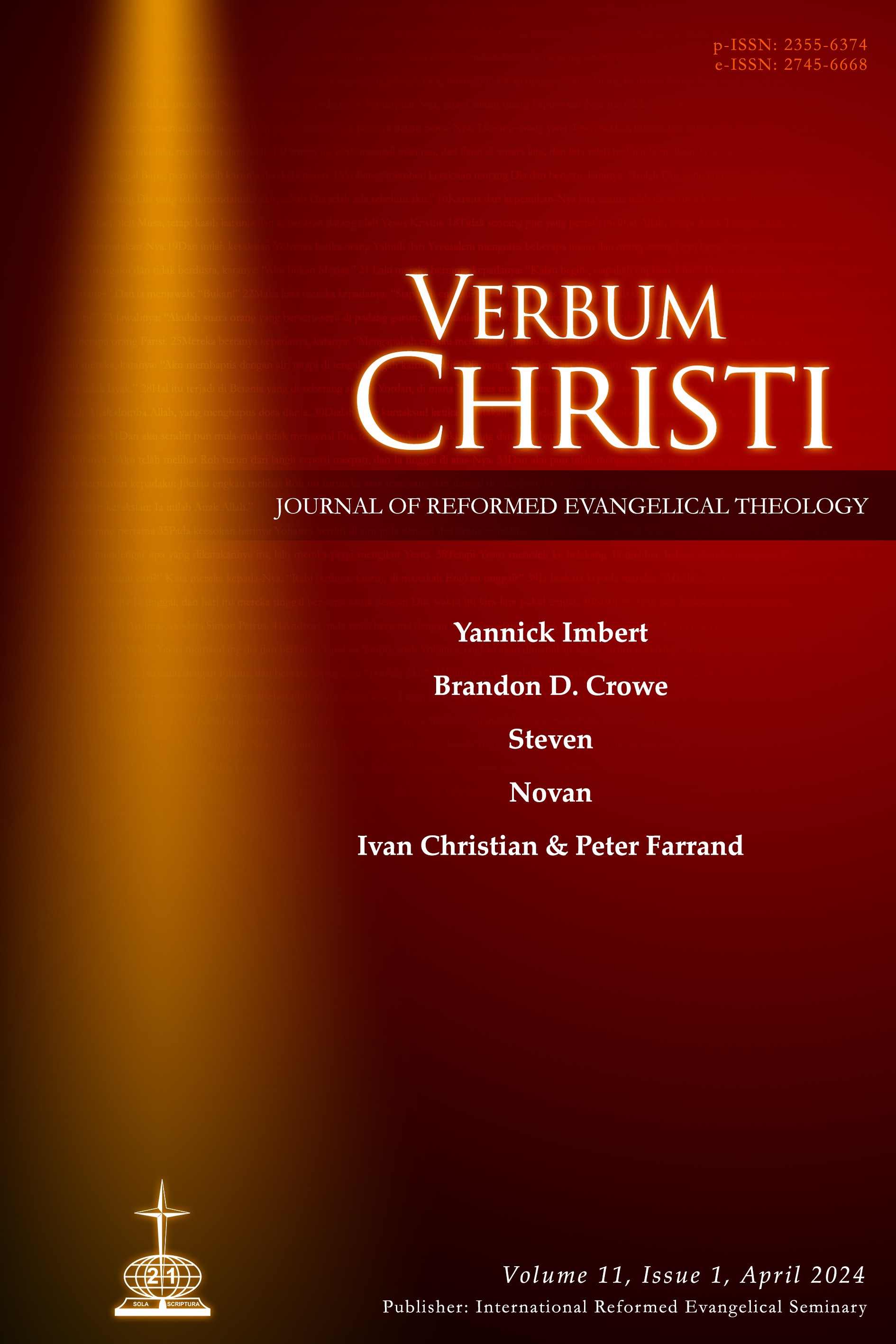“But Saul Held His Peace”
Sebuah Analisis Leksikal-Sintaktis 1 Samuel 10:27
DOI:
https://doi.org/10.51688/VC11.1.2024.art3Kata Kunci:
kritik tekstual, analisis leksikal-sintaktis, eksegesis, 1 Samuel 10Abstrak
Sebuah masalah muncul dalam teks 1 Samuel 10:27 karena kata כמחריש dalam MT yang mana kata tersebut signifikan, baik dalam hal transmisi teks maupun interpretasi eksegesis. Dalam konteks naratif, sebagian mempertanyakan kredibilitas Saul setelah ia ditunjuk sebagai raja pertama Israel, yang mengakibatkan kritik terhadap raja baru Israel tersebut. Menariknya, beberapa penafsiran menyarankan respons Saul terhadap komentar-komentar ini dalam 1 Samuel 10:27, sementara yang lain tetap diam. Artikel ini mengusulkan sebuah solusi terhadap ayat tersebut dengan menggunakan kritik tekstual yang bertujuan untuk mengidentifikasi kata yang paling cocok untuk כמחריש dengan memperhatikan konteks narasi yang lebih luas dan melakukan analisis leksikal-sintaktis terhadap perikop tersebut. Artikel ini berargumen bahwa koreksi yang dibuat oleh LXX, didukung oleh DSS dan tulisan-tulisan Yosefus, lebih dekat dengan teks asli.
Unduhan
Referensi
Balfour, Rory J. “Rejection Realized: Saul, the Evil Spirit and the Loss of Kingship,” Journal for the Study of the Old Testament, 47, no. 2 (2022): 206–22. https://doi.org/10.1177/03090892221116918.
Botterweck, G. Johannes, and Ringgren, eds. “חרש.” In Theological Dictionary of the Old Testament. Vol. 5. Grand Rapids: William B. Eerdmans, 1986.
Campbell, Antony F. 1 Samuel. Vol. 7. The Forms of the Old Testament Literature. Grand Rapids: William B. Eerdmans, 2003.
Cappel, Louis. Critica Sacra. Paris: Cramoisy, 1650.
Condrea, Vasile. A Text-Linguistic Reading of 1 Samuel. Syntactic Studies in Targum Aramaic. New Jersey: Georgias Press, 2020.
Cross, Frank Moore. “The Ammonite Oppression of the Tribes of Gad and Reuben: Missing Verses from 1 Samuel 11 Found in 4QSamuela.” In History, Historiography and Interpretation. Studies in Biblical and Cuneiform Literatures. Jerusalem: Magnes, 1983.
Cross, Frank Moore, Donald W. Parry, Richard J. Saley, and Eugene Ulrich. Qumran Cave 4.XII: 1-2 Samuel. Discoveries in the Judaean Desert XVII. Oxford: Clarendon Press, 2005.
Decker, Aaron J. “Multivalent Readings of Multivalent Texts: 1 Samuel 10:27 and the Problem of Textual Variants in the Interpretation of Scripture,” Currents in Theology and Mission, 41, no. 6 (2014): 412–16.
Diehl, Johannes Friedrich, and Markus Witte, eds. “חרש.” In Hebräisches Und Aramäisches Wörterbuch Zum Alten Testament. Berlin: De Gruyter, 2021.
Elliger, Karl, and Willhelm Rudolph, eds. Biblia Hebraica Stuttgartensia. Stuttgart: Deutsche Bibelgesellschaft, 1997.
Glover, Daniel B. “Is Josephus Among the Qumranites?: Unraveling a Textual Conondrum in 1 Samuel 10:27,” Zeitschrift für die alttestamentliche Wissenschaft, 132, no. 2 (2020): 266–80. https://doi.org/10.1515/zaw-2020-2005.
Gordon, C. H. The Common Background of Greek and Hebrew Civilizations. New York: W. W. Norton, 1965.
Herbert, Edward D. “4QSama and Its Relationship to the LXX: An Exploration in Stemmatological Analysis.” In IX Congress of the International Organization for Septuagint and Cognate Studies, edited by Bernard A. Taylor. Atlanta: Scholars Press, 1995.
Hwang, Jerry. “Yahweh’s Poetic Mishpat in Israel’s Kingship: A Reassessment of 1 Samuel 8-12,” Westminster Theological Journal, 73, no. 2 (2011): 341–61.
Jenni, Ernst, and Claus Westermann, eds. “חרש.” In Theologisches Handwörterbuch Zum Alten Testament. Vol. 1. München: Theologischer Verlag Zürich, 1976 1971.
Josephus. Jewish Antiquities Books V-VIII. Translated by Henry St. John Thackeray and Ralph Marcus. Vol. 5. Cambridge: Harvard University Press, 1950.
Keil, C. F., and Franz Delitzsch. Commentary on 1 Chronicles. Grand Rapids: William B. Eerdmans, 1949.
Klein, Ralph W. 1 Samuel. Vol. 10. Word Biblical Commentary. Grand Rapids: Zondervan, 2000.
Ming, D. “Reflection on the Leadership Practice of Saul as a Failure of Leadership for Church Pastors,” Acta Theologica, 42, no. 2 (2022): 294–310. http://dx.doi.org/10.18820/23099089/actat.v42i2.19.
Rahlfs, Alfred, and Robert Hanhart, eds. Septuaginta: Id Est Vetus Testamentum Graece Iuxta LXX Interpretes. Stuttgart: Deutsche Bibelgesellschaft, 2006.
Rofé, Alexander. “The Acts of Nahash According to 4QSama.” Israel Exploration Journal 32, no. 2 (1982): 129–33.
Stuart, Douglas. Old Testament Exegesis: A Handbook for Students and Pastors. Louisville: Westminster John Knox Press, 2009.
Suharto, Daniel, Muner Daliman, and Yonathan Salmon Efrayim Ngesthi. “Persistent Leadership: Constructive Reflections on Saul’s Leadership Model,” Pharos Journal of Theology, 104, no. 1 (2023): 1–10. https://doi.org/10.46222/pharosjot.10424.
Tov, Emanuel. The Text-Critical Use of the Septuagint in Biblical Research. 3rd ed. Winona Lake, Indiana: Eisenbrauns, 2015.
Tsumura, David Toshio. The First Book of Samuel. The New International Commentary on the Old Testament. Grand Rapids: William B. Eerdmans, 2007.
Ulrich, Eugene. The Qumran Text of Samuel and Josephus. Vol. 19. Harvard Semitic Monographs. Missoula: Scholars Press, 1978.
Unduhan
Diterbitkan
Cara Mengutip
Terbitan
Bagian
Lisensi
Artikel ini mengikuti ketentuan Creative Commons Attribution-NonCommercial 4.0 International License.
Hak Cipta (c) 2024 Verbum Christi: Jurnal Teologi Reformed Injili. Hak tersebut dipegang jurnal dengan sepengetahuan penulis.




